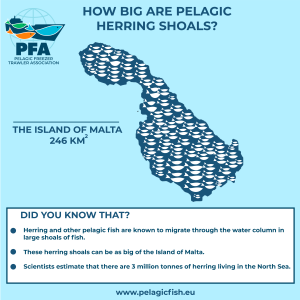Pelagic Fisheries
Pelagic (Latin: pelagius/pelagicus) means ‘of the sea’ and is the ecological zone in seas and oceans consisting of open water, home to a variety of pelagic fish including herring, mackerel, horse mackerel and blue whiting. These fish are known to migrate through the water column in large shoals of fish of approximately the same size. Swimming in shoals makes the group less vulnerable to attacks of predators.
PFA vessels will fish for North Sea herring in the coming weeks. Herring is one of those pelagic fish species and scientists estimate there are 3 million tonnes – or 3 000 000 000 kg of herring living in the North Sea or about 50 billion herring in total. To give an idea of how big these groups are: a school of herring can be as high as 100 metres and contain up to a million fish. Looking from above, these shoals can be as big as the island of Malta (246 km²).
Only a small part of this large herring population is fished as PFA vessels adhere to available (strict) quota, leaving most of the fish in the sea (about 80%) to grow, and reproduce, hereby keeping the fish stock healthy. Quota calculations explicitly take into account that herring is eaten by other fish species, birds and marine mammals. For example, when there is a lot of cod in the North Sea, one of the main predators for herring, it also means that less can be caught by the fishery to ensure sufficient food for this predatory fish is left in the sea.
This ensures that North Sea herring is caught sustainably and has been so since the mid 90’s. When comparing it with a bank account, in North Sea fisheries, only the interest is caught, and the capital remains in the bank/sea.
Read more about our fishing activities in the Channel the coming weeks: PFA members start herring fishing that is key to food security – Pelagic Freezer Trawler Association (pelagicfish.eu)

Date Posted: 24th November 2023